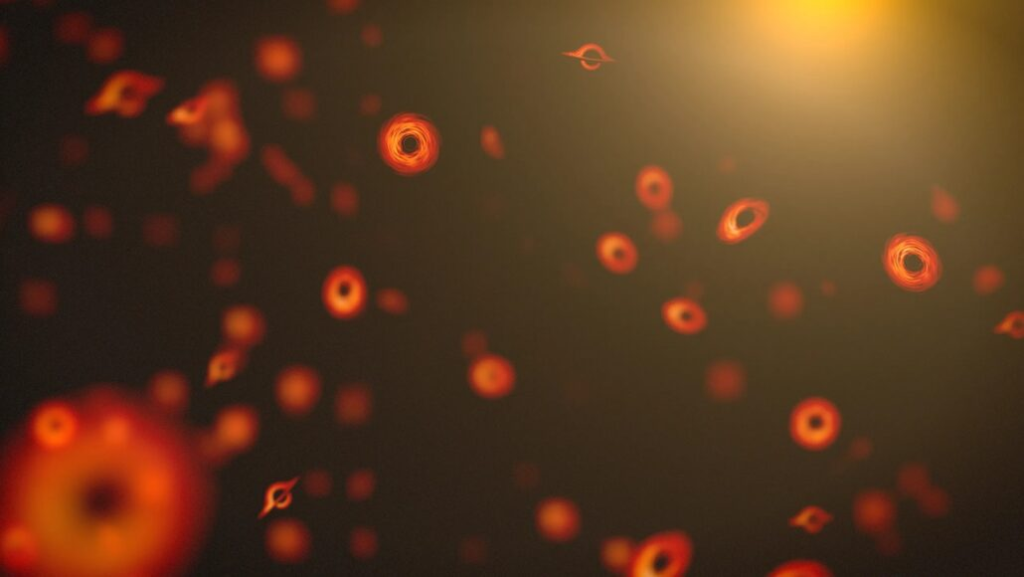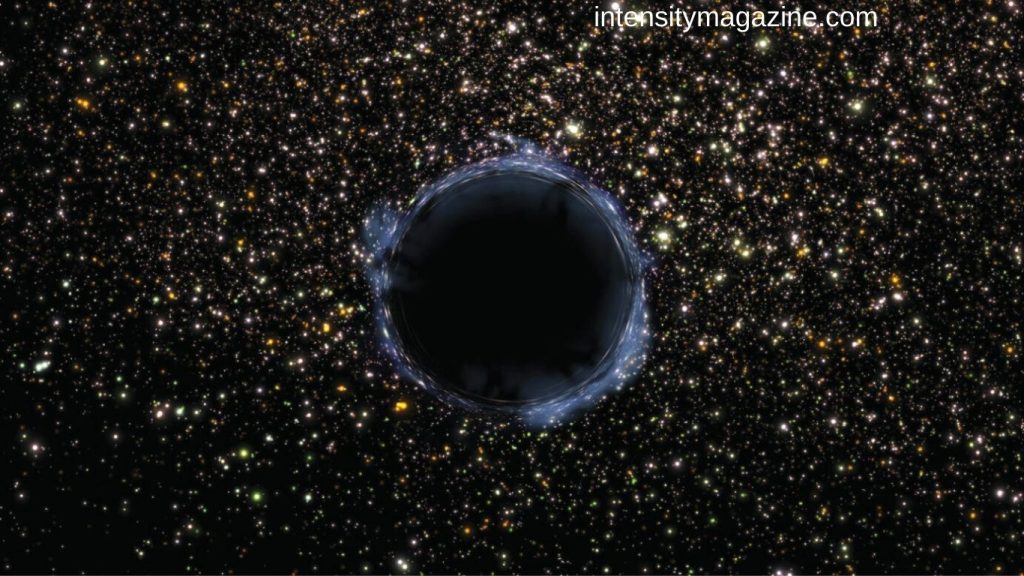Dark Matter Mystery___A hidden population of ancient black holes may be scattered throughout the universe, potentially holding answers to some of cosmology’s deepest mysteries. Unlike the black holes we already know—stellar and supermassive—these primordial black holes would have formed mere moments after the Big Bang, long before stars or galaxies existed.
Primordial black holes are not just theoretical curiosities. Over the past decade, scientists have renewed their search for them, and signs may already be lurking in the cosmos. These ancient objects could emit energy, bend starlight with their gravity, or even devour stars from within. Cosmologist Bernard Carr of Queen Mary University in London predicts we might confirm their existence within the next decade. “I would bet 60 to 70 percent that they exist,” he says, noting a personal hope that they do.
Why Primordial Black Holes Matter
If primordial black holes exist, they could explain several puzzling cosmic phenomena. Gravitational waves from black hole mergers, the rapid growth of supermassive black holes, and the enigmatic nature of dark matter are all potential clues. Dark matter, which makes up six times the mass of all ordinary matter, exerts gravitational influence that shapes galaxies but remains invisible. Primordial black holes, with their immense gravity yet unseen presence, could account for at least a portion of this dark substance.

Interest in primordial black holes surged after 2016, when scientists detected gravitational waves for the first time. These ripples in spacetime originated from two colliding black holes, each about 30 times the mass of the Sun. This discovery raised questions, as these black holes were larger than typical stellar black holes yet far smaller than supermassive ones. Cosmologist Simeon Bird of the University of California recalls initially dismissing the idea that they might be primordial. “What a silly idea,” he admits—but further evidence suggested otherwise.
Gravitational Waves and the Hunt for the Ancient
Since that first detection, more than 80 black hole mergers have been observed by instruments like LIGO in the U.S., Virgo in Italy, and KAGRA in Japan. Many features of these mergers remain puzzling: the slow spins of black holes, the frequency of mergers between vastly different masses, and their distribution across cosmic time. Primordial black holes could explain these anomalies, according to cosmologists such as Sébastien Clesse of Université Libre de Bruxelles.
The formation of primordial black holes likely traces back to the earliest moments of the universe. During inflation—a rapid expansion of the universe just after the Big Bang—tiny variations in energy density could have become so extreme that some regions collapsed into black holes. These primordial objects might range from the mass of a small animal to that of Mount Everest, even extending to planetary or stellar masses. Some may even explain unusual gravitational wave observations, although clear evidence is still lacking.
Detecting Primordial Black Holes
Scientists agree on two key signs that would confirm the existence of primordial black holes. The first is discovering a black hole that predates the first stars and galaxies, appearing within the first 100 million years after the Big Bang. Because light and gravitational waves travel over vast distances, observing extremely distant signals allows astronomers to probe the ancient universe. Current detectors like LIGO cannot reach back far enough, but future observatories—such as the space-based LISA, the Einstein Telescope, and the Cosmic Explorer—may change that.

The second clue would be detecting a black hole with a mass roughly equal to or less than the Sun. Stellar black holes, which form from collapsing stars, are always several times more massive than the Sun. A smaller black hole would strongly suggest a primordial origin. Such discoveries could be within reach of the next generation of gravitational wave detectors.
Black Holes Inside Stars
Gravitational waves aren’t the only path to discovery. Some theorists speculate that small primordial black holes embedded in stars could produce observable effects. For example, as a black hole consumes stellar material, it could heat the surrounding plasma, creating unusual light emissions. These “Hawking stars” might resemble red giant stars known as red stragglers. Monitoring the light from these stars over time could reveal hidden black holes, offering an indirect method of detection.
Echoes of Black Holes That No Longer Exist
Even primordial black holes that have evaporated could leave behind cosmic fingerprints. Shortly after inflation, tiny black holes may have absorbed quarks and gluons, acquiring a property called color charge. Smaller black holes with residual color charge would have vanished long ago, but they could have influenced the ratios of light elements in the early universe. Such imprints could indicate that larger, neutral primordial black holes still survive today, potentially contributing to dark matter.
Primordial Black Holes and Dark Matter

Traditionally, dark matter has been attributed to hypothetical, yet-undetected particles. After decades of searching with no success, confidence in particle-based explanations is waning. Cosmologist Anne Green of the University of Nottingham likens the search to looking for a needle in a haystack—so far, the needle remains elusive. Primordial black holes offer a tangible alternative: black holes are real, and the physics of their formation, while extreme, is at least plausible.
However, forming black holes this early requires adjustments to standard models of cosmic inflation. Typical inflationary models do not produce the extreme energy density variations needed to create primordial black holes. “I have to really do some violence to the model to get it to make black holes,” notes cosmologist Will Kinney of the University of Buffalo.
Accounting for all dark matter would require a precise balance: enough black holes at the right masses. Smaller black holes have already evaporated, and overly massive black holes would have been detected through gravitational effects or radiation. Many scientists suggest that black holes with asteroid-like masses could explain most dark matter, though some argue sun-sized black holes might also contribute.
The Future of Primordial Black Hole Research
Even if primordial black holes do not fully explain dark matter, the research itself is invaluable. Studying these objects sheds light on the early universe, offering insights into the formation of cosmic structures and the behavior of matter under extreme conditions. As observational technology advances, from next-generation gravitational wave observatories to precise stellar monitoring, the hunt for primordial black holes may finally yield answers.
Whether they are the key to dark matter or simply a remarkable relic of the early universe, primordial black holes represent one of the most exciting frontiers in modern astrophysics. As scientists continue to probe the cosmos, these ancient enigmas may soon move from theoretical speculation to confirmed reality, illuminating mysteries that have puzzled humanity for decades.
Frequently Asked Questions:
What are primordial black holes?
Primordial black holes are theoretical black holes believed to have formed shortly after the Big Bang, long before stars and galaxies existed.
How are primordial black holes different from regular black holes?
Regular black holes form when massive stars collapse, while primordial black holes may have formed directly from dense regions of energy in the early universe.
Why are scientists so interested in primordial black holes?
These ancient black holes could explain unusual gravitational wave patterns, the rapid growth of supermassive black holes, and the mystery of dark matter.
Can primordial black holes really solve the dark matter puzzle?
Yes, many scientists believe primordial black holes might account for part—or even all—of the unseen dark matter that holds galaxies together.
How do scientists search for primordial black holes?
They look for clues in gravitational waves, unusual stellar behavior, light distortions from gravity, and cosmic imprints left in the early universe.
Have primordial black holes been discovered yet?
No direct evidence has been found, but ongoing gravitational wave research and upcoming space missions may provide answers in the coming decades.
Could small primordial black holes exist inside stars?
Some theories suggest tiny primordial black holes could hide within stars, possibly altering their light and structure.
Conclusion
The mystery of dark matter remains one of the greatest puzzles in modern science, but primordial black holes may hold the key to solving it. These ancient cosmic giants, born in the earliest moments after the Big Bang, could explain strange gravitational wave patterns, the rapid growth of supermassive black holes, and the invisible matter that shapes galaxies. While no direct evidence has yet been found, the next generation of observatories promises to bring us closer than ever before. Whether they fully account for dark matter or simply reveal new truths about the universe’s infancy, primordial black holes remind us that the cosmos still holds secrets waiting to be unlocked.



